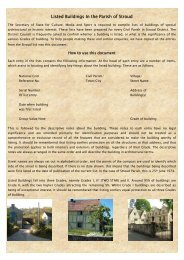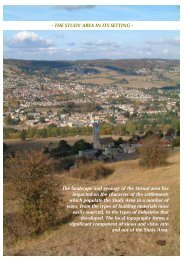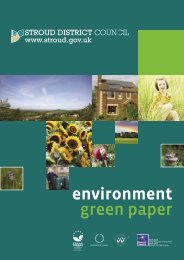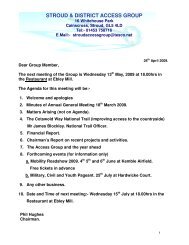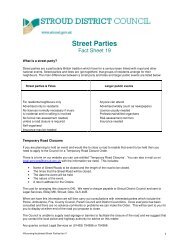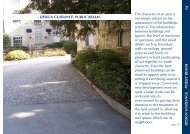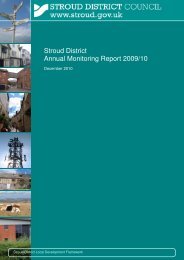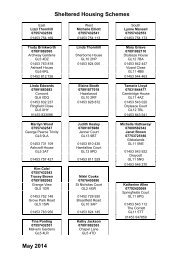CONSERVATION AREA STATEMENT - Stroud District Council
CONSERVATION AREA STATEMENT - Stroud District Council
CONSERVATION AREA STATEMENT - Stroud District Council
You also want an ePaper? Increase the reach of your titles
YUMPU automatically turns print PDFs into web optimized ePapers that Google loves.
SUB <strong>AREA</strong> 1: CHURCH END<br />
Origins and evolution of the built environment<br />
This is the site of the first recognizably cohesive settlement at Frampton on Severn, the historic cradle of the village,<br />
based around the medieval feudal core of church, manor house and farm.<br />
The heart of the former hamlet Church End is quite tight knit, with dwellings clustered closely. Some houses have<br />
been demolished – the original Denfurlong Cottages, a pair of cruck-framed cottages which stood opposite Oegrove<br />
Farm, were lost as late as 1966. Several new houses were built in gap sites throughout Church End in the mid -late<br />
20th century, and more recent times have seen the addition of Tanfield and the traditionally constructed Kaowen.<br />
However, the area as we see it today is mostly 17th and 18th century.<br />
Uses<br />
This part of the village was once a hub of industrial and agricultural activity, as well as being an important domestic<br />
settlement and the religious centre. Until recently, the spiritual tranquillity of the churchyard sat in close alliance with<br />
the very temporal bustle of the farmyard.<br />
Historically, the smells and sounds of some of the most anti-social manufacturing processes emanated from the area.<br />
In the 18th century, in addition to a dusty, fume- filled brickyard and limekiln virtually adjacent to the church, and a<br />
pungent malthouse for the brewing of beer nearby, there was also a tannery at Church End.<br />
The tannery, which was first mentioned in 1791, preserved leather by leaving it submerged for months in swampy,<br />
dank infusions of water and tannin-rich oak bark. It, and its associated bark- stripping mill, remained on the site until<br />
the late 19th century and gave its name to the much earlier Tanhouse Farm.<br />
The large barn, now part of Tanhouse Farm, was reputedly rebuilt in its present distinctive form after a violent storm<br />
in 17th century. Its predecessor was probably originally a tythe barn used for the storage of goods paid in lieu of<br />
money to the rector of the parish.<br />
The medieval heart of Frampton on Severn has seen a steady decline in activity and, to an extent, relative to its great<br />
historic importance, status. Denfurlong Farm remains in agricultural use and there is a group of industrial buildings<br />
near to the canal, however, following the conversion of many of the Tanhouse farm buildings into holiday lets, most<br />
of the hamlet is now a peacefully residential, quiet backwater, a full stop to the village.<br />
The Buildings in Sub Area 1: Church End<br />
Early buildings and materials<br />
<strong>CONSERVATION</strong> <strong>AREA</strong> <strong>STATEMENT</strong> - Conservation Area No7: FRAMPTON ON SEVERN<br />
In spite of the fact that the hamlet at Church End almost certainly dates from at least the 14th century, there is very<br />
little of the truly ancient settlement left. The methods of construction, the materials used, and change in the status<br />
and functions of buildings often made the early structures rather ephemeral and easily lost.<br />
The earliest building is the church of St Mary the Virgin. The present church dates largely from the beginning of the<br />
14th century, however it is highly likely that it replaced much earlier religious buildings on the site.<br />
<strong>Stroud</strong> <strong>District</strong> <strong>Council</strong><br />
17



